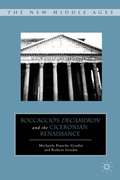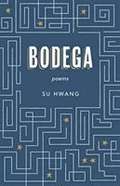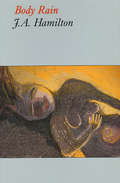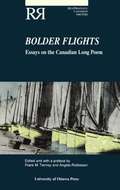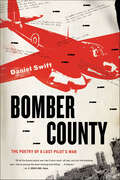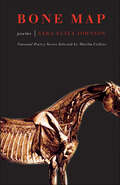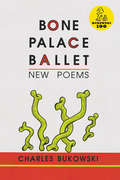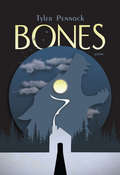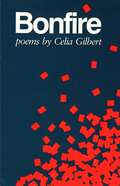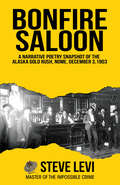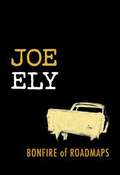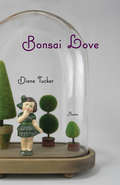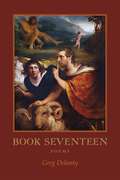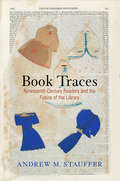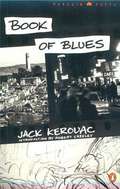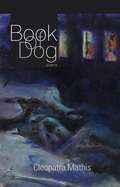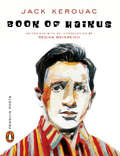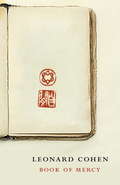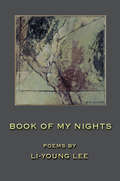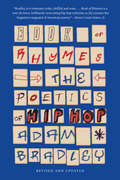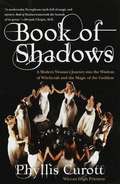- Table View
- List View
Boccaccio’s Decameron And The Ciceronian Renaissance
by Michaela Paasche Grudin Robert GrudinBoccaccio's Decameron and the Ciceronian Renaissance demonstrates that Boccaccio's puzzling masterpiece takes on organic consistency when viewed as an early modern adaptation of a pre-Christian, humanistic vision.
Bodega: Poems
by Su HwangIn Su Hwang's rich lyrical and narrative poetics, the bodega and its surrounding neighborhoods are cast not as mere setting, but as an ecosystem of human interactions where a dollar passed from one stranger to another is an act of peaceful revolution, and desperate acts of violence are "the price / of doing business in the projects where we / were trapped inside human cages--binding us / in a strange circus where atoms of haves / and have-nots always forcefully collide." These poems also reveal stark contrasts in the domestic lives of immigrants, as the speaker's own family must navigate the many personal, cultural, and generational chasms that arise from having to assume a hyphenated identity--lending a voice to the traumatic toll invisibility, assimilation, and sacrifice take on so many pursuing the American Dream. <p><p> "We each suffer alone in / tandem," Hwang declares, but in Bodega, she has written an antidote to this solitary hurt--an incisive poetic debut that acknowledges and gives shape to anguish as much as it cherishes human life, suggesting frameworks for how we might collectively move forward with awareness and compassion.
Body Rain
by J. A. HamiltonShortlisted for the 1991 Pat Lowther Award In J.A. Hamilton's poems blood is red, black hearts are black. There is no flinching from things as bad as they can be, especially but not only for women. And yet, this passionate powerful writing radiates affirmation. "his good o, good old world" is livable still in acts of pure verbal magic.
Bolder Flights: Essays on the Canadian Long Poem
by Frank M. Tierney Angela RobbesonA growing number of literary historians and critics now recognize the contemporary long poem as a distinctively Canadian genre. This collection of essays leads the reader to a deeper understanding of Canadian literary cultures in terms of their local intimacies and idiosyncrasies as well as in their national contexts.
Bomber County: The Poetry of a Lost Pilot's War
by Daniel SwiftIn early June 1943, James Eric Swift, a pilot with the 83rd Squadron of the Royal Air Force, boarded his Lancaster bomber for a night raid on Münster and disappeared.Widespread aerial bombardment was to the Second World War what the trenches were to the First: a shocking and new form of warfare, wretched and unexpected, and carried out at a terrible scale of loss. Just as the trenches produced the most remarkable poetry of the First World War, so too did the bombing campaigns foster a haunting set of poems during the Second.In researching the life of his grandfather, Daniel Swift became engrossed with the connections between air war and poetry. Ostensibly a narrative of the author's search for his lost grandfather through military and civilian archives and in interviews conducted in the Netherlands, Germany, and England, Bomber County is also an examination of the relationship between the bombing campaigns of World War II and poetry, an investigation into the experience of bombing and being bombed, and a powerful reckoning with the morals and literature of a vanished moment.
Bone Map: Poems
by Sara Eliza Johnson&“These poems, like light, clarify even as they pierce.&” —PUBLISHERS WEEKLYSelected for the National Poetry Series by Martha Collins, Sara Eliza Johnson&’s stunning, deeply visceral first collection pulls shards of tenderness from a world on the verge of collapse.Here violence and terror infuse the body, the landscape, and dreams: a handful of blackberries offered from bloodied arms, bee stings likened to pulses of sunlight, a honeycomb of marrow exposed. &“All moments will shine if you cut them open. / Will glisten like entrails in the sun.&” With figurative language that makes long, associative leaps, and with metaphors and images that continually resurrect themselves across poems, Bone Map builds and transforms its world through a locomotive echo—a regenerative force—that comes to parallel the psychic quest for redemption that unfolds in its second half. The result is a deeply affecting composition that establishes Sara Eliza Johnson as a vital new voice in American poetry.
Bone Palace Ballet
by Charles BukowskiThis is a collection of 175 previously unpublished works by Bukowski. It contains yarns about his childhood in the Depression and his early literary passions, his apprentice days as a hard-drinking, starving poetic aspirant, and his later years when he looks back at fate with defiance.
Bones
by Tyler PennockPoems about a young two-spirit Indigenous man moving through shadow and trauma toward strength and awareness. Bones, Tyler Pennock’s wise and arresting debut, is about the ways we process the traumas of our past, and about how often these experiences eliminate moments of softness and gentleness. Here, the poems journey inward, guided by the world of dreams, seeking memories of a loving sister lost beneath layers of tragedy and abuse. With bravery, the poems stand up to the demons lurking in the many shadows of their lines, seeking glimpses of a good that is always just out of reach.At moments heartrending and gut-punching, at others still and sweet, Bones is a collection of deep and painstaking work that examines the human spirit in all of us. This is a hero’s journey and a stark look at the many conditions of the soul. This is a book for survivors, for fighters, for dreamers, and for believers. “Here is a spare and urgent voice that speaks of ‘wounds and beauty,’ that gestures to a story of trauma and abuse while offering us a potent journey of self-reckoning and reclamation.
Bonfire
by Celia Gilbert"Bonfire is a passionate, controlled book by an extraordinary poet. First is evident the lucidity of intelligence; then the radiance; and finally the sheer power."--Josephine Jacobsen"From deep places, these poems allow things to well up: memory, love, fear, and a sense of how our individual natures belong to the same great nature which keeps pushing life forward out of death... In 'Lot's Wife' and other poems, Gilbert reinvents mythology, bringing it closer to the realities we recognize."--Alicia Ostriker
Bonfire Saloon: A Narrative Poetry Snapshot of the Alaska Gold Rush, Nome, December 3, 1903
by Steve LeviThe Alaska Gold Rush is the least studied era of United States history. If you pull up Alaska Gold Rush on Wikipedia, you will get the Klondike Gold Rush. The Klondike Gold Rush was centered around Dawson in Canada's Yukon Territory and lasted 14 months. The Alaska Gold Rush lasted 40 years, from 1880 to the end of the First World War, and covered an area one-fifth that of the Lower 48 states. Bonfire Saloon is not a work of narrative poetry. It is a book of history disguised as literature. The slang, words, terms, and expressions would be used in a saloon in 1903 in a gold rush. The names of the people are authentic, and the events in the book happened. Bonfire Saloon is a ground-level look at the events and personalities of 39 individuals on a single night in a Nome saloon.
Bonfire of Roadmaps
by Joe Ely"In Bonfire, I can't help but think of the Beat writers--Corso, Ginsberg, Burroughs, and mostly, of course, Kerouac. . . . Bonfire of Roadmaps, at its very best, is about where music comes from and how it comes from. It offers us a glimpse into the heart of music. . . . This book is true. "--Terry AllenSince he first hitched a ride out of Lubbock, Texas, at the age of sixteen, singer-songwriter and Flatlanders band member Joe Ely has been a road warrior, traveling highways and back roads across America and Europe, playing music for "2 hours of ecstasy" out of "22 hours of misery. " To stay sane on the road, Ely keeps a journal, penning verses that sometimes morph into songs, and other times remain "snapshots of what was flying by, just out of reach, so to savor at a later date when the wheels stop rolling, and the gears quit grinding, and the engines shut down. " In Bonfire of Roadmaps, Ely takes readers on the road with him. Using verse passages from his road journals and his own drawings, Ely authentically re-creates the experience of a musician's life on tour, from the hard goodbyes at home, to the long hours on the road, to the exhilaration of a great live show, to the exhaustion after weeks of touring. Ely's road trips begin as he rides the rails to Manhattan in 1972 and continue up through recent concert tours with fellow Flatlanders Jimmie Dale Gilmore and Butch Hancock. While acknowledging that "it is not the nature of a gypsy to look in the rearview mirror," Joe Ely nevertheless offers his many fans a revelatory look back over the roads he's traveled and the wisdom he's won from his experiences. And for "those who want to venture beyond the horizon just to see what is there . . . to those, I hope these accounts will give a glint of inspiration . . . "
Bonsai Love: Poems
by Diane L. TuckerDiane Tucker’s Bonsai Love is an eloquent book of poems about the sensual delicacy of love. Carefully pruned, intricate in design, and sensitive to intrusion, these poems create an image of intimacy through reflection and in relation to nature, the universe, music, literature and art.
Book Seventeen: Poems
by Greg DelantyPurporting to be a "lost" seventeenth book of the 16-volume Anthologia Graeca, Book Seventeen uses the themes and images of ancient mythology to conjure a new way of looking at our modern world. Gods of all types line the pages of this collection, from those deities that only operate in our personal spaces-the poet's companion, the demigod Solitude, as well as the elusive god of Complicity-to more familiar divinities in unfamiliar roles, such as Helios shopping in an outdoor market in Paris, or an aging Aphrodite in a short skirt chatting with visitors to an unfamiliar city. Pithy and humorous, reverential and impudent, Greg Delanty's poems showcase the author's keen eye for the mythologies on which we depend to make sense of our messy, bewildering lives.
Book Traces: Nineteenth-Century Readers and the Future of the Library (Material Texts)
by Andrew M. StaufferIn most college and university libraries, materials published before 1800 have been moved into special collections, while the post-1923 books remain in general circulation. But books published between these dates are vulnerable to deaccessioning, as libraries increasingly reconfigure access to public-domain texts via digital repositories such as Google Books. Even libraries with strong commitments to their print collections are clearing out the duplicates, assuming that circulating copies of any given nineteenth-century edition are essentially identical to one another. When you look closely, however, you see that they are not.Many nineteenth-century books were donated by alumni or their families decades ago, and many of them bear traces left behind by the people who first owned and used them. In Book Traces, Andrew M. Stauffer adopts what he calls "guided serendipity" as a tactic in pursuit of two goals: first, to read nineteenth-century poetry through the clues and objects earlier readers left in their books and, second, to defend the value of keeping the physical volumes on the shelves. Finding in such books of poetry the inscriptions, annotations, and insertions made by their original owners, and using them as exemplary case studies, Stauffer shows how the physical, historical book enables a modern reader to encounter poetry through the eyes of someone for whom it was personal.
Book of Blues
by Jack KerouacBest known for his "Legend of Duluoz" novels, including On the Road and The Dharma Bums, Jack Kerouac is also an important poet. In these eight extended poems, Kerouac writes from the heart of experience in the music of language, employing the same instrumental blues form that he used to fullest effect in Mexico City Blues, his largely unheralded classic of postmodern literature. Edited by Kerouac himself, Book of Blues is an exuberant foray into language and consciousness, rich with imagery, propelled by rythm, and based in a reverent attentiveness to the moment. "In my system, the form of blues choruses is limited by the small page of the breastpocket notebook in which they are written, like the form of a set number of bars in a jazz blues chorus, and so sometimes the word-meaning can carry from one chorus into another, or not, just like the phrase-meaning can carry harmonically from one chorus to the other, or not, in jazz, so that, in these blues as in jazz, the form is determined by time, and by the musicians spontaneous phrasing & harmonizing with the beat of time as it waves & waves on by in measured choruses. " -Jack Kerouac .
Book of Dog
by Cleopatra MathisInfluenced by survival lessons from the natural world, Cleopatra Mathis' Book of Dog traces a harrowing personal journey from hard endings-a divorce, the death of a beloved dog-to the fierce arrival of acceptance and change. All manner of life thrives in these pages-plovers, foxes, the companionable beetle on the bedpost, and the coyotes just beyond her back door. This poet's discerning eye, focused on the stringent truth of what she sees around her, aims outward and refuses the sentimental. Throughout the search, she is guided by the unbounded faithfulness and wisdom of her noble and comic companions on the path.
Book of Haikus
by Jack KerouacRenowned for his groundbreaking Beat Generation novel On the Road, Jack Kerouac was also a master of the haiku, the three-line, seventeen-syllable Japanese poetic form. Following in the tradition of Basho, Buson, Shiki, Issa, and other poets, Kerouac experimented with this centuries-old genre, taking it beyond strict syllable counts into what he believed was the form’s essence. He incorporated his 'American’ haiku in novels and in his correspondence, notebooks, journals, sketchbooks, and recordings. In this edition, Kerouac scholar Regina Weinreich has supplemented a core haiku manuscript from Kerouac’s archives with a generous selection of the rest of his haikus, from both published and unpublished sources. The result is a compact collection of more than five hundred poems that reveal a lesser known but important side of Jack Kerouac’s literary legacy.
Book of Mercy
by Leonard CohenPopular since its original publication more than 25 years ago, Leonard Cohen's classic book of contemporary psalms is now beautifully repackaged. Internationally celebrated for his writing and his music, Leonard Cohen is revered as one of the great writers, performers, and most consistently daring artists of our time. Now beautifully repackaged, the poems in Book of Mercy brim with praise, despair, anger, doubt and trust. Speaking from the heart of the modern world, yet in tones that resonate with an older devotional tradition, these verses give voice to our deepest, most powerful intuitions. From the Trade Paperback edition.
Book of My Nights
by Li-Young LeeBook of My Nights is the first poetry collection in ten years by one of the world's most acclaimed young poets. In Book of My Nights, Li-Young Lee once again gives us lyrical poetry that fuses memory, family, culture and history. In language as simple and powerful as the human muscle, these poems work individually and as a full-sequence meditation on the vulnerability of humanity.Marketing Plans: o National advertising o National media campaign o National and regional author appearances o Advance reader copies o Course adoption mailingLi-Young Lee burst onto the American literary scene with the publication of Rose, winner of the 1986 Delmore Schwartz Memorial Poetry Award from The Poetry Society of America. He followed that astonishing book with The City in Which I Love You, which was The Lamont Poetry Selection of The Academy of American Poets. Mr. Lee has appeared on National Public Radio a number of times and The Power of the Word, the PBS television series with Bill Moyers. Rose and The City in Which I Love You are in the 19th and 17th printings respectively, making them two of the highest-selling contemporary poetry books in the United States. Moreover, Mr. Lee's poems have been translated into more than a dozen languages. He currently lives in Chicago.
Book of My Nights (American Poets Continuum)
by Li-Young LeeBook of My Nights is the first poetry collection in ten years by one of the world's most acclaimed young poets. In Book of My Nights, Li-Young Lee once again gives us lyrical poetry that fuses memory, family, culture and history. In language as simple and powerful as the human muscle, these poems work individually and as a full-sequence meditation on the vulnerability of humanity.Marketing Plans: o National advertising o National media campaign o National and regional author appearances o Advance reader copies o Course adoption mailingLi-Young Lee burst onto the American literary scene with the publication of Rose, winner of the 1986 Delmore Schwartz Memorial Poetry Award from The Poetry Society of America. He followed that astonishing book with The City in Which I Love You, which was The Lamont Poetry Selection of The Academy of American Poets. Mr. Lee has appeared on National Public Radio a number of times and The Power of the Word, the PBS television series with Bill Moyers. Rose and The City in Which I Love You are in the 19th and 17th printings respectively, making them two of the highest-selling contemporary poetry books in the United States. Moreover, Mr. Lee's poems have been translated into more than a dozen languages. He currently lives in Chicago.
Book of Nonsense
by Edward LearThe owls, hen, larks, and their nests in his beard, are among the fey fauna and peculiar persons inhabiting the uniquely inspired nonsense rhymes and drawings of Lear (20th child of a London stockbroker), whose Book of Nonsense, first published in 1846, stands alone as the ultimate and most loved expression in English of freewheeling, benign, and unconstricted merriment.
Book of Poems: A Dual-Language Book (Dover Dual Language Spanish)
by Federico García Lorca Stanley AppelbaumThe passionate life and violent death of Federico Garcia Lorca (1898-1936) retain an enduring fascination for readers around the world. Murdered by Nationalists at the outset of the Spanish Civil War, Lorca died at the peak of his creative powers. He remains his country's most widely translated writer, surpassed only by Cervantes in terms of critical commentary.This selection includes 55 of the 68 poems that comprised Lorca's 1921 Libro de poemas, all of them in their entirety and in their original sequence. Imbued with the spirit and folklore of the poet's native Andalusia, these verses feature the most complex spiritual content of any of Lorca's works. Editor Stanley Appelbaum provides sensitive, accurate English translations on the pages facing the original Spanish, as well as an informative introduction to the author's life and oeuvre, plus notes on the individual poems. An outstanding resource for students and teachers of Spanish language and literature, this compilation will enchant any lover of poetry.
Book of Rhymes: The Poetics of Hip Hop
by Adam BradleyIf asked to list the greatest innovators of modern American poetry, few of us would think to include Jay-Z or Eminem in their number. And yet hip hop is the source of some of the most exciting developments in verse today. The media uproar in response to its controversial lyrical content has obscured hip hop's revolution of poetic craft and experience: Only in rap music can the beat of a song render poetic meter audible, allowing an MC's wordplay to move a club-full of eager listeners.Examining rap history's most memorable lyricists and their inimitable techniques, literary scholar Adam Bradley argues that we must understand rap as poetry or miss the vanguard of poetry today. Book of Rhymes explores America's least understood poets, unpacking their surprisingly complex craft, and according rap poetry the respect it deserves.
Book of Shadows: A Modern Woman's Journey into Witchcraft and the Magic of the Goddess
by Phyllis CurottThis is a true story of one woman's spiritual journey and the profound influence of that journey in her life. It is a story of enlightenment and growth and holds something for everyone from the merely curious to the seasoned practitioner.
